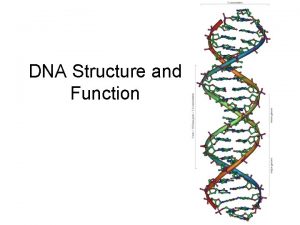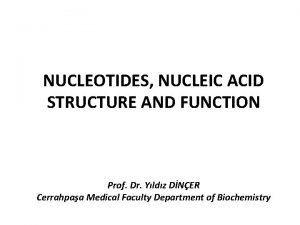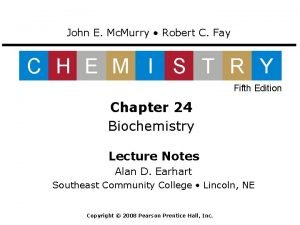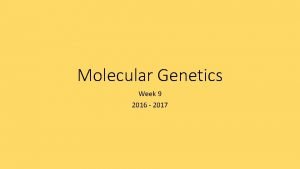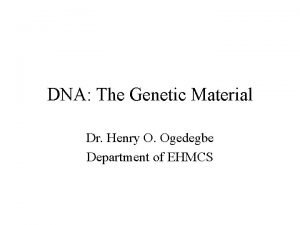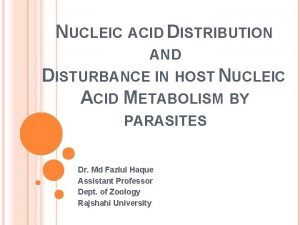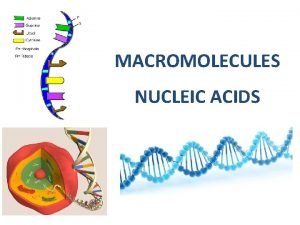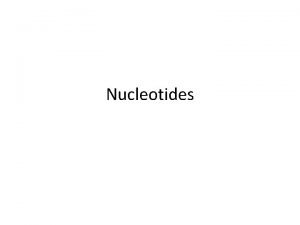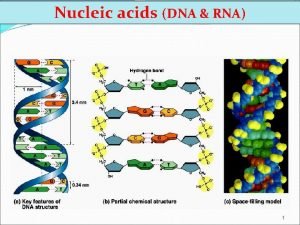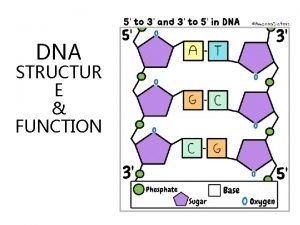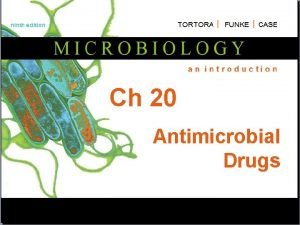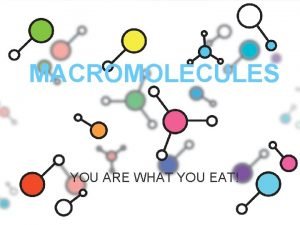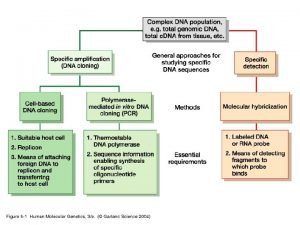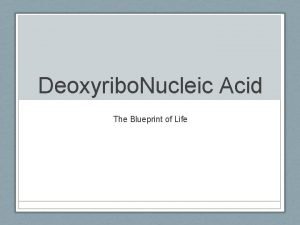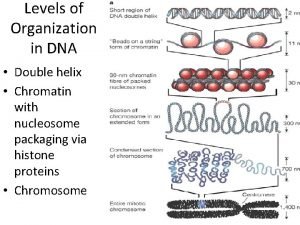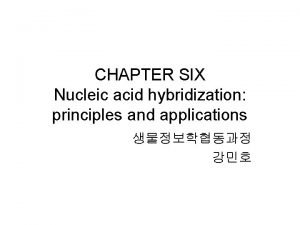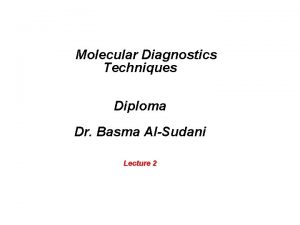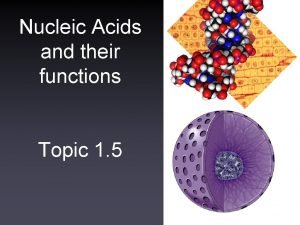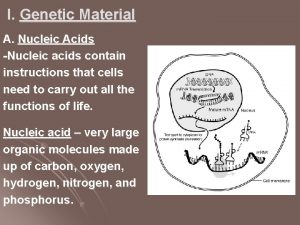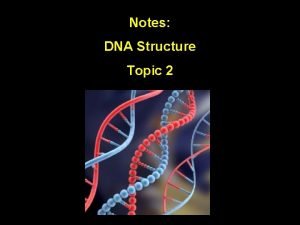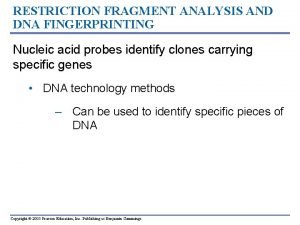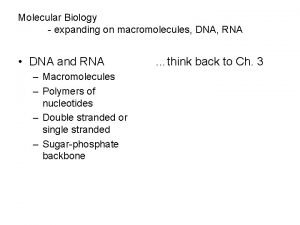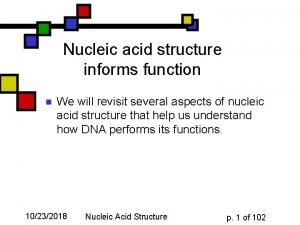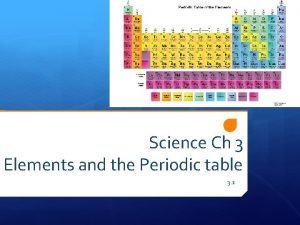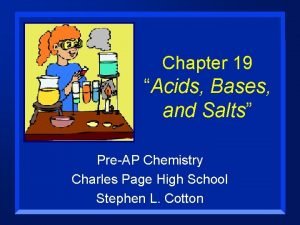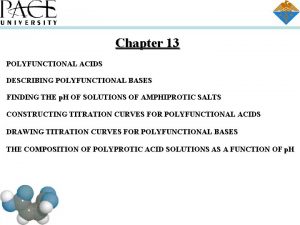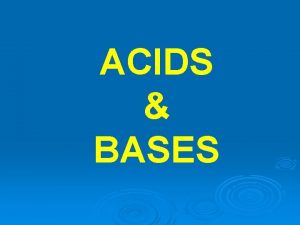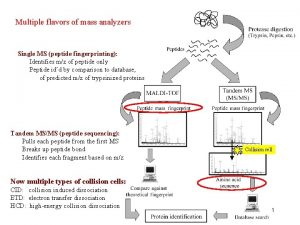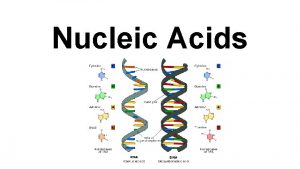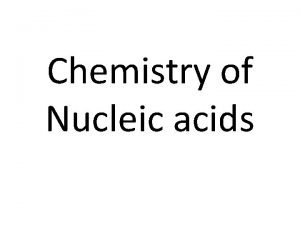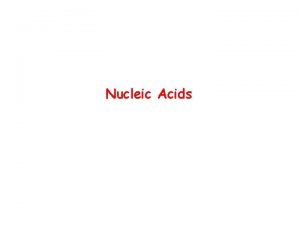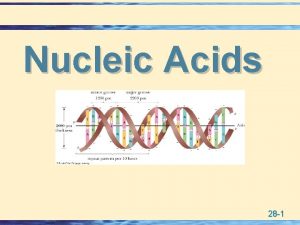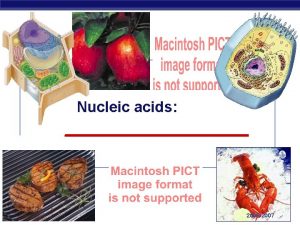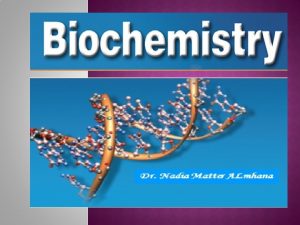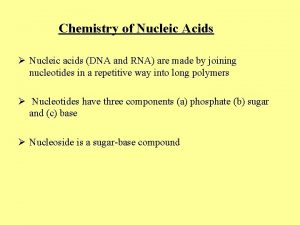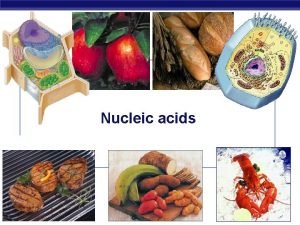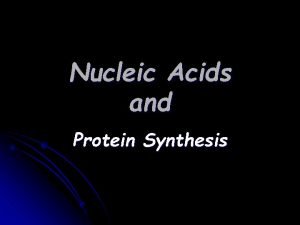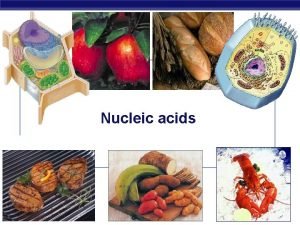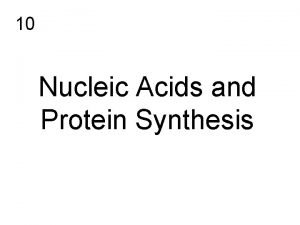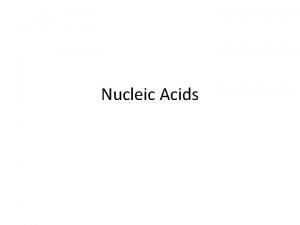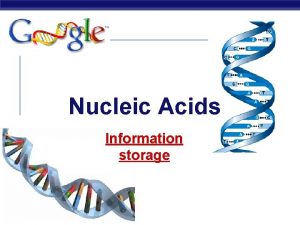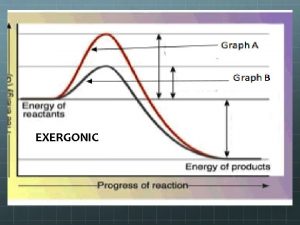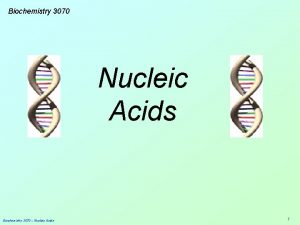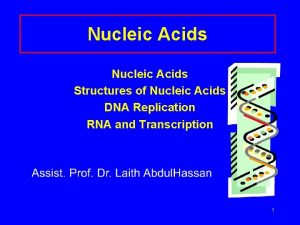Nucleic acids II Nucleic Acids 1 Elements C















































- Slides: 47

Nucleic acids

II. Nucleic Acids 1. Elements: C, H, O, N, P

Nucleic Acids Function: Stores genetic information n n DNA transfers information n n proteins genes blueprint for building proteins n DNA RNA proteins blueprint for new cells blueprint for next generation

II. Nucleic Acids Function: store hereditary info DNA • Double-stranded helix • N-bases: A, G, C, Thymine • Stores hereditary info • Longer/larger • Sugar: deoxyribose RNA • Single-stranded • N-bases: A, G, C, Uracil • Carry info from DNA to ribosomes • t. RNA, r. RNA, m. RNA, RNAi • Sugar: ribose

Nucleotides: monomer of DNA/RNA Nucleotide = Sugar + Phosphate + Nitrogen Base

phosphat e Nucleotide 5 -C sugar Nitrogen base Purines A–T G–C Pyrimidines • Adenine • Guanine • Cytosine • Thymine (DNA) • Uracil (RNA) • Double ring • Single ring

Memory Help: “Students at AG (middle school) are still PURE.

Dehydration Synthesis forms the Sugar-Phosphate Backbone

N-bases

Information flow in a cell: DNA RNA protein

Carbohydrates

III. Carbohydrates • Ratio of 1 carbon: 2 hydrogen: 1 oxygen or CH 2 O • Monomers = Monosaccharides (eg. glucose, ribose)

III. Carbohydrates • monosaccharide disaccharide polysaccharide

Sugars 1. Most names for sugars end in -ose 2. Classified by number of carbons 6 C = hexose (glucose) 5 C = pentose (ribose) 3 C = triose (glyceraldehyde) n n n CH 2 OH H HO O H OH 6 H Glucose H OH H CH 2 OH OH C O H HO H 5 OH O HO H Ribose H H C OH 3 OH H Glyceraldehyde

Functional groups determine function carbonyl aldehyde carbonyl ketone

The structure and classification of some monosaccharides

Linear and ring forms of glucose

III. Carbohydrates Examples/Types: • Simple sugars: Fructose, Glucose, Ribose • Complex Polysaccharides: Starch, Cellulose, Glycogen

III. Carbohydrates • Functions: • Fuel (energy) and building material § § Differ in Storage (plants-starch, animals-glycogen) position & orientation of Structure (plant-cellulose, arthropod/fungi-chitin ) glycosidic linkage

Building sugars 1. Dehydration synthesis monosaccharides | glucose disaccharide | glucose | maltose glycosidic linkage

Building sugars 1. Dehydration synthesis monosaccharides | glucose disaccharide | fructose | sucrose (table sugar)

Carbohydrate synthesis

Cellulose vs. Starch Two Forms of Glucose: glucose & glucose

Cellulose vs. Starch • • Starch = glucose monomers Cellulose = glucose monomers

Storage polysaccharides of plants (starch) and animals (glycogen)

Linear vs. branched polysaccharides starch (plant) energy storage glycogen (animal)

Polysaccharide diversity Molecular structure determines function in starch in cellulose isomers of glucose u structure determines function… u

Structural polysaccharides: cellulose & chitin (exoskeleton)

Lipids: Fats & Oils

IV. Lipid Structure 1. Elements: C, H, O 2. Monomers: Fatty Acids Glycerol*

IV. Lipids A. Fats (triglyceride): store energy n n Glycerol + 3 Fatty Acids saturated, unsaturated, polyunsaturated B. Steroids: Steroids cholesterol and hormones C. Phospholipids: lipid bilayer of cell membrane n hydrophilic head, hydrophobic tails Hydrophilic head Hydrophobic tail

Phospholipid

The structure of a phospholipid

Structure: n Phospholipids glycerol + 2 fatty acids + PO 4 n PO 4 = negatively charged It’s just like a penguin… A head at one end & a tail at the other!

Phospholipids Hydrophobic or hydrophilic? n n n fatty acid tails = hydrophobic PO 4 head =hydrophillic “attracted to water” split “personality” Come here, No, go away! interaction with H 2 O is complex & very important! “repelled by water”

Phospholipids in water 1. Hydrophilic heads “attracted” to H 2 O 2. Hydrophobic tails “hide” from H 2 O can self-assemble into “bubbles” n n bubble = “micelle” can also form a phospholipid bilayer early evolutionary stage of cell? water bilayer water

Why is this important? 1. Phospholipids create a barrier in water n n define outside vs. inside they make cell membranes! Tell them about soap!

Hydrophobic/hydrophilic interactions make a phospholipid bilayer

Building Fats Triacylglycerol n n 3 fatty acids linked to glycerol ester linkage = between OH & COOH hydroxyl carboxyl

Dehydration synthesis dehydration synthesis enzyme H 2 O enzyme


Saturated Unsaturated Polyunsaturated “saturated” with H, so NO double bonds Have some C=C (double bonds), result in kinks In animals In plants Solid at room temp. Liquid at room temp. Eg. butter, lard Eg. corn oil, olive oil

Cholesterol, a steroid

Cholesterol 1. Important cell component n n animal cell membranes precursor of all other steroids n n including vertebrate sex hormones high levels in blood may contribute to cardiovascular disease

Cholesterol Important component of cell membrane helps keep cell membranes fluid & flexible

From Cholesterol Sex Hormones 1. What a big difference a few atoms can make!

 Dna polymer and monomer
Dna polymer and monomer Nucleoide funcion
Nucleoide funcion Hystonia
Hystonia Nucleic acids
Nucleic acids Purpose of nucleic acid
Purpose of nucleic acid Stores hereditary information
Stores hereditary information Nucleic acids concept map
Nucleic acids concept map Ehmcs
Ehmcs Dna nucleotide
Dna nucleotide Nucleic acid
Nucleic acid Nucleic acid building block
Nucleic acid building block Nucleoside and nucleotide
Nucleoside and nucleotide Biological importance of nucleotides
Biological importance of nucleotides How are macromolecules separated or digested
How are macromolecules separated or digested Nucleic acid test
Nucleic acid test What is nucleic acid composed of
What is nucleic acid composed of Types of rna and dna
Types of rna and dna Complementary dna strand
Complementary dna strand Inhibition of nucleic acid synthesis
Inhibition of nucleic acid synthesis Nucleic acid test
Nucleic acid test Infectious nucleic acid
Infectious nucleic acid Rugae of mucosa
Rugae of mucosa Nucleic acid
Nucleic acid Nucleic acid
Nucleic acid Nucleic acid monomer
Nucleic acid monomer Different parts of chromosomes
Different parts of chromosomes Kalju kahn
Kalju kahn Principle of hybridization
Principle of hybridization Nucleic acid dna structure
Nucleic acid dna structure Types of nucleic acid
Types of nucleic acid Nucleic
Nucleic Nucleic acid made up of
Nucleic acid made up of Nucleic acid structure
Nucleic acid structure Nucleic acid
Nucleic acid Nucleic acid chart
Nucleic acid chart Nucleic acid
Nucleic acid Oracle landed cost management
Oracle landed cost management The elements of folktales
The elements of folktales Molecular element
Molecular element Http //elements.wlonk.com/elements table.htm
Http //elements.wlonk.com/elements table.htm Elements of drama.
Elements of drama. Features of a folk tale
Features of a folk tale Chapter 19 acids bases and salts
Chapter 19 acids bases and salts Polyfunctional acids
Polyfunctional acids Acids and bases
Acids and bases ácido de arrhenius
ácido de arrhenius Mixed amino acids
Mixed amino acids Seven strong acids
Seven strong acids
